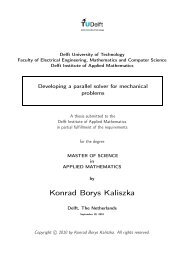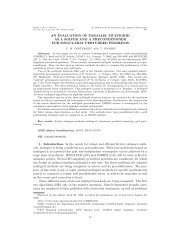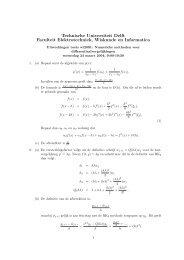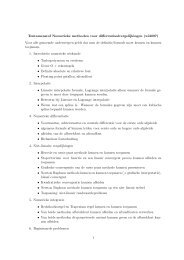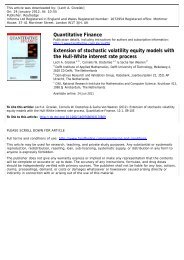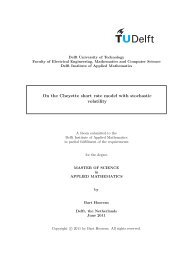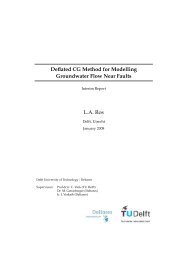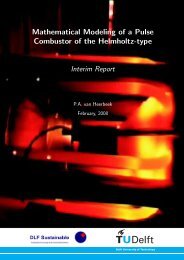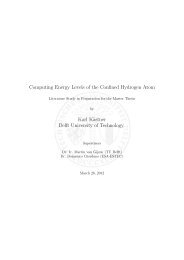Modeling bone regeneration around endosseous implants
Modeling bone regeneration around endosseous implants
Modeling bone regeneration around endosseous implants
Create successful ePaper yourself
Turn your PDF publications into a flip-book with our unique Google optimized e-Paper software.
1.3. Review of mathematical models for <strong>bone</strong> <strong>regeneration</strong> 5• representation of biological tissues as linear elastic, visco-elastic orporo-elastic (biphasic) media;• choice of the mechanical stimulus (strain energy, hydrostatic stress,deviatoric strain, fluid flow etc.);• representation of the considered cellular processes (random diffusion,chemotaxis and haptotaxis for cell migration, immediate and evolutionarycell differentiation, etc.);• phases of <strong>bone</strong> <strong>regeneration</strong> represented (reparation phase and/or remodelingphase).The focus of this manuscript is on the processes taking place during thereparation phase of <strong>bone</strong> <strong>regeneration</strong>. In this work, <strong>bone</strong> remodeling isnot considered in detail. Bone remodels constantly throughout the entirelife of an organism. The time scale of this process is much larger thanthe time scale of the reparation processes [24]. For extended mathematicalmodels for <strong>bone</strong> remodeling see Doblaré and García-Aznar [27], García-Aznar et al. [34], Pivonka et al. [75], Ryser et al. [85] and references therein.Bone remodeling is out of the scope of the current work. Therefore, adetailed review of the models, mainly developed for the reparation phase of<strong>bone</strong> <strong>regeneration</strong>, is given in the remainder of this section.Geris et al. [42] divide the models into three classes with respect to theessential mechanisms regulating the <strong>bone</strong> <strong>regeneration</strong> process. They distinguishmechanoregulatory models, bioregulatory models and mechanobioregulatorymodels. Such a classification has the advantage, that it reflectsthe chronological perspective of the mathematical modeling of <strong>bone</strong> <strong>regeneration</strong>.In mechanoregulatory models, the local mechanical environmentis considered as the only factor that influences the path of <strong>bone</strong> <strong>regeneration</strong>.On the contrary, in bioregulatory models only biochemical factors,like the influence of growth factors on various cell processes, are considered.Mechanobioregulatory models employ mechanical and biological effects simultaneously.An extended review of mathematical models for <strong>bone</strong> <strong>regeneration</strong> ispresented in Geris et al. [42]. The authors track the history of the developmentof several mathematical approaches to <strong>bone</strong> <strong>regeneration</strong>. Further,they outline the connections between various theoretical works and they listsome references to the original model formulations and to the numericalstudies carried out to verify applicability and to evaluate and compare theperformance of various approaches.First theoretical studies of <strong>bone</strong> <strong>regeneration</strong> were related to mechanoregulationof <strong>bone</strong> healing. Pauwels [72] defined a model for tissue differentiationdepending on local stresses and strains. Pauwels assumed, that deviatoricstrains promote formation of fibrous tissue and a hydrostatic pressure



